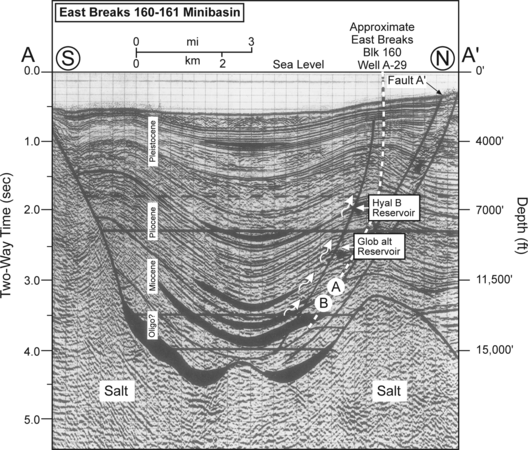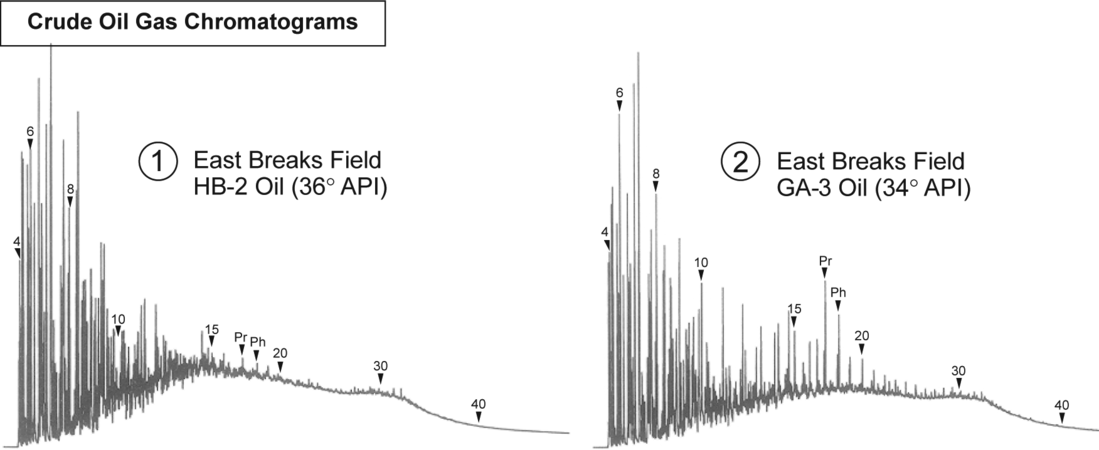East Breaks geochemistry
| Exploring for Oil and Gas Traps | |

| |
| Series | Treatise in Petroleum Geology |
|---|---|
| Part | Critical elements of the petroleum system |
| Chapter | Sedimentary basin analysis |
| Author | John M. Armentrout |
| Link | Web page |
| Store | AAPG Store |
Two oil samples (Glob alt = GA-3 and Hyal B = HB-2) from two different reservoirs in the East Breaks 160-161 field provide data for modeling the history of hydrocarbon generation and migration within this minibasin. Dow et al.[1] report that the East Breaks oils are biodegraded and mixed lower molecular weight, thermally mature oil. The C10 through C30 alkanes of the GA-3 oil are better preserved than those of the HB-2 oil. This is demonstrated by the higher peaks of C10 through C30 alkanes on the gas chromatograms below, suggesting that the stratigraphically deeper GA-3 oil is less degraded and slightly more mature than the stratigraphically shallower HB-2 oil. Neither oil exhibits evidence of evaporative fractionation reported by Thompson[2] in over 75% of Gulf Coast Tertiary oils.
Oil preservation pattern
Figure 1 The more poorly preserved alkanes in the HB-2 oil occur where the reservoir temperature is about 130°F. After Dow et al.[1] Copyright: Gulf Coast SEPM.
Figure 2 whole oil chromatograms of crude oils from two reservoirs in the East Breaks 160-161 field. Copyright: Dow et al.[1] Courtesy Gulf Coast SEPM.
The oil preservation pattern is attributed to the history of generation, expulsion, secondary migration, and accumulation.[1] The better preserved C10 to C30 alkanes in the GA-3 oil occur where the reservoir temperature is about temperature::160°F (temperature::71°C). The more poorly preserved alkanes in the HB-2 oil occur where the reservoir temperature is about temperature::130°F (Figure 1). Microbial activity responsible for biodegradation occurs at temperatures below temperature::140°F (temperature::60°C). The earliest migration fluids would have been the least mature and potentially most biodegraded due to the shallow level of accumulation. With increasing burial of the source rock, more mature oil and condensate would have been generated and better preserved in deeper reservoirs below the depth of microbial activity. These observations suggest sequential expulsion and migration of progressively more mature products as the source(s) passed through the oil window. Alternative interpretations are offered in Dow et al.[1]
Figure 2 shows whole oil chromatograms of crude oils from two reservoirs in the East Breaks 160-161 field. Oil 1 is from the HB-2 reservoir; oil 2 is from the Glob alt GA-3 reservoir. Both are interpreted as biodegraded and mixed with fresh oil, suggesting multiple pulses of accumulation.
See also
- East Breaks petroleum system
- East Breaks trap formation
- East Breaks hydrocarbon generation model
- East Breaks hydrocarbon migration model
- East Breaks hydrocarbon accumulation model
- East Breaks critical moment
References
- ↑ 1.0 1.1 1.2 1.3 1.4 Dow, W. G., M. A. Yukler, J. T. Senftle, M. C. Kennicutt, and J. M. Armentrout, 1990, Miocene oil source beds in the East Breaks basin, Flex-Trend, offshore Texas: Proceedings, Gulf Coast Section SEPM 9th Annual Research conference, p. 139–150.
- ↑ Thompson, K. F. M., 1987, Fractionated aromatic petroleums and the generation of gas-condensates: Organic Geochemistry, vol. 11, p. 573–590., 10., 1016/0146-6380(87)90011-8

